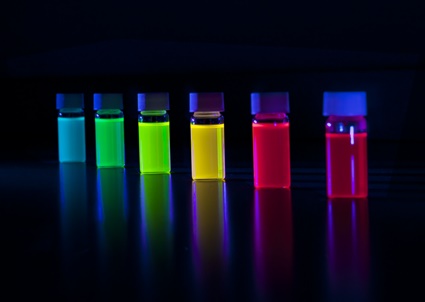Electronic Coatings: Functions & Applications
Electronic coatings – not to be confused with conformal coats or encapsulation resins – are a group of components used to improve the optoelectronic properties of PCBs (printed circuit boards), ICs (integrated circuits), and macroscale devices.
Conformal coatings and encapsulation resins are thin polymeric films designed to surround the contours of PCBs and ICs to protect against contaminants (dielectric chemicals, dust, moisture, etc.) and adverse conditions such as high operating temperatures. While there may be physical benefits associated with certain electronic coatings, their primary function is to impart greater optical and electrical properties to devices. Among the main functions are:
- Antireflection
- Charge transport
- Downconversion / upconversion
- Electroluminescence
- High refractive index (RI)
- Photoluminescent

Antireflection & High RI Electronic Coatings
Antireflection and high RI (<1.95) electronic coatings are linked in the sense that both are concerned with moderating the photonic properties of substrates, and they are often used in tandem. This allows engineers to generate transparent materials with anti-reflective properties with alternating refractive indices.
Electronic coatings comprising one, or both, of these material types are used in various applications where light must pass through optical surfaces; which is an incredibly broad cross-section. Correctional lenses, handheld electronics, organic photovoltaics (OPVs), photolithographic equipment, and many more devices make increasing use of antireflective and high RI materials to optimize light attenuation or various other visible properties.
Charge Transport Electronic Coatings
Electronic coatings are routinely applied in thin-film engineering for the purposes of charge transport and current optimization. Formulations of this kind are often characterized according to their electrical function (i.e. hole or electron transport), which determines how well they facilitate a unidirectional charge in semiconducting junctions. The primary markets for charge transport electronic coatings include organic and perovskite photovoltaics, and large panel displays such as organic light-emitting diodes (OLEDs) and quantum-dot enhanced LEDs (QLEDs).
Downconversion / Upconversion Electronic Coatings
Down- and upconversion electronic coatings are of primary interest to the display sector, which has never seen more variety in terms of device architecture and available picture formats. They enable high-definition images to be scaled down to a standard definition picture for lower resolution displays, and vice versa. The result varies depending on the quality of the electronic coating and the differential between the available number of pixels and the quality of the content.
Electroluminescent & Photoluminescent Electronic Coatings
Electro- and photoluminescent electronic coatings have an extremely broad range of potential areas of application but are currently used primarily in electronics applications. Materials with electroluminescent properties are extremely valuable in display manufacturing as they provide the foundation for efficiently recreating vibrant images on screens using electrical excitation. Likewise, photoluminescent materials will illuminate light of finely-tuned wavelengths when excited by the appropriate electromagnetic signal.
For more information on this type of electronic coating, complete and submit our contact form and a member of the team will get back to you as soon as possible.
Electronic Coatings from Avantama
Avantama is one of the world’s leading manufacturers of electronic coating materials for high-performance electronics and photonics components. With a uniquely wide range of processing capabilities, we can service numerous market segments worldwide, from display to solar applications.
If you would like more information about Avantama electronic coatings, simply contact a member of the team today for more information.